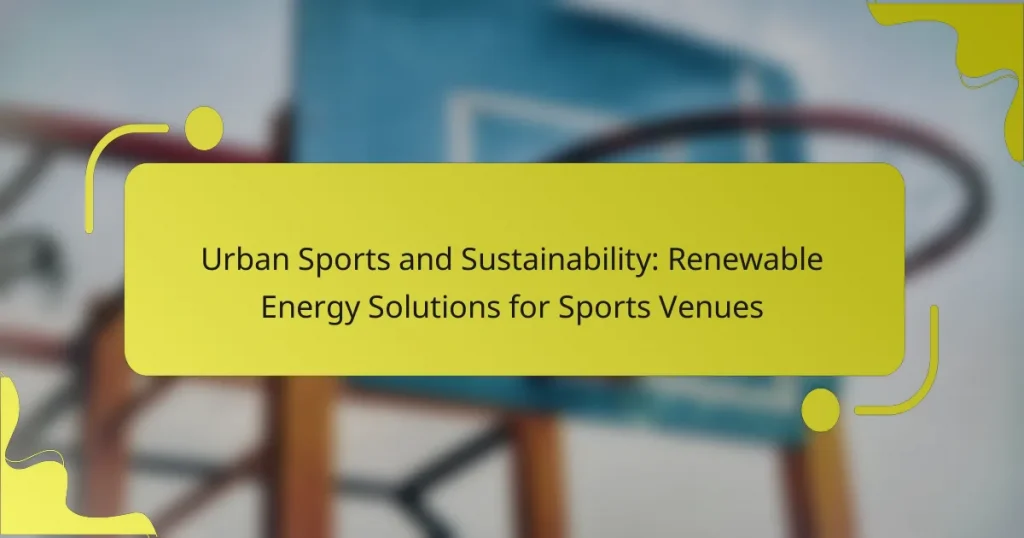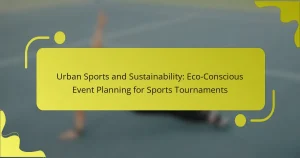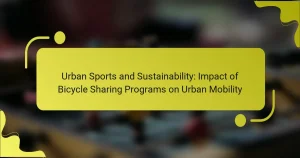Urban sports venues are increasingly adopting renewable energy solutions to enhance sustainability and reduce carbon footprints. This article explores the integration of solar panels, wind turbines, and energy-efficient systems in these venues. It examines successful case studies, community engagement initiatives, and future trends in renewable energy technologies. The focus is on how these innovations not only lower operational costs but also promote environmental responsibility.
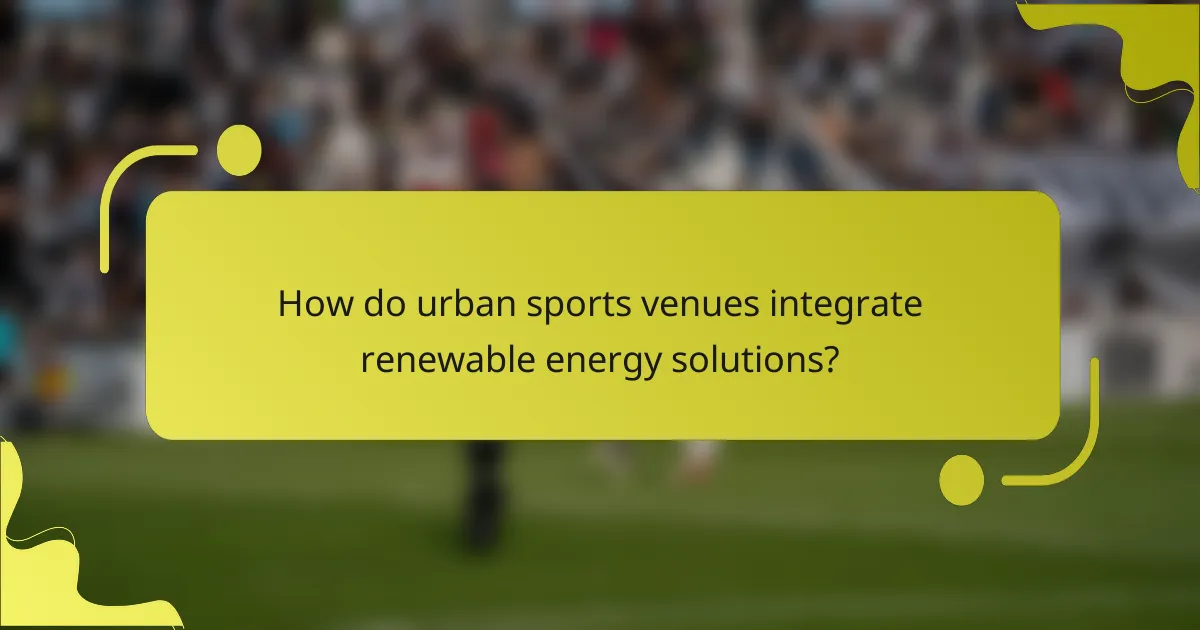
How do urban sports venues integrate renewable energy solutions?
Urban sports venues increasingly integrate renewable energy solutions to enhance sustainability. These venues utilize solar panels, wind turbines, and energy-efficient systems to reduce carbon footprints.
Solar energy installations can provide significant power, with some venues generating up to 100% of their energy needs. Wind energy complements this by harnessing natural resources, particularly in open areas. Energy-efficient lighting and HVAC systems further minimize energy consumption.
In addition, many venues implement smart grid technologies to optimize energy use and manage demand. This integration not only lowers operational costs but also promotes environmental responsibility, aligning with global sustainability goals.
What are the benefits of using renewable energy in sports venues?
Using renewable energy in sports venues offers significant benefits, including reduced operational costs, decreased carbon footprint, and enhanced community engagement. These venues can lower energy expenses by utilizing solar panels or wind turbines, resulting in long-term savings. Additionally, adopting renewable sources contributes to sustainability goals, promoting environmental stewardship. Sports venues can also attract eco-conscious fans, enhancing their reputation and fostering a positive community image.
Which renewable energy sources are most commonly used in urban sports venues?
Solar energy, wind energy, and geothermal energy are the most commonly used renewable energy sources in urban sports venues.
Solar panels are frequently installed on rooftops and parking lots, providing clean energy for lighting and electronic systems. Wind turbines can be integrated into venue designs, harnessing local wind patterns for additional power. Geothermal systems utilize the earth’s stable temperatures for heating and cooling, enhancing energy efficiency.
These solutions not only reduce carbon footprints but also lower operational costs, making urban sports venues more sustainable.
How does renewable energy impact the operational costs of sports venues?
Renewable energy can significantly reduce the operational costs of sports venues. By utilizing solar panels, wind turbines, and energy-efficient systems, venues lower energy bills and decrease reliance on traditional energy sources. For instance, venues that implement solar energy can save up to 50% on electricity costs annually. Additionally, renewable energy solutions often qualify for tax incentives, further enhancing cost savings. This shift not only supports sustainability but also attracts environmentally conscious sponsors and fans, fostering a positive brand image.
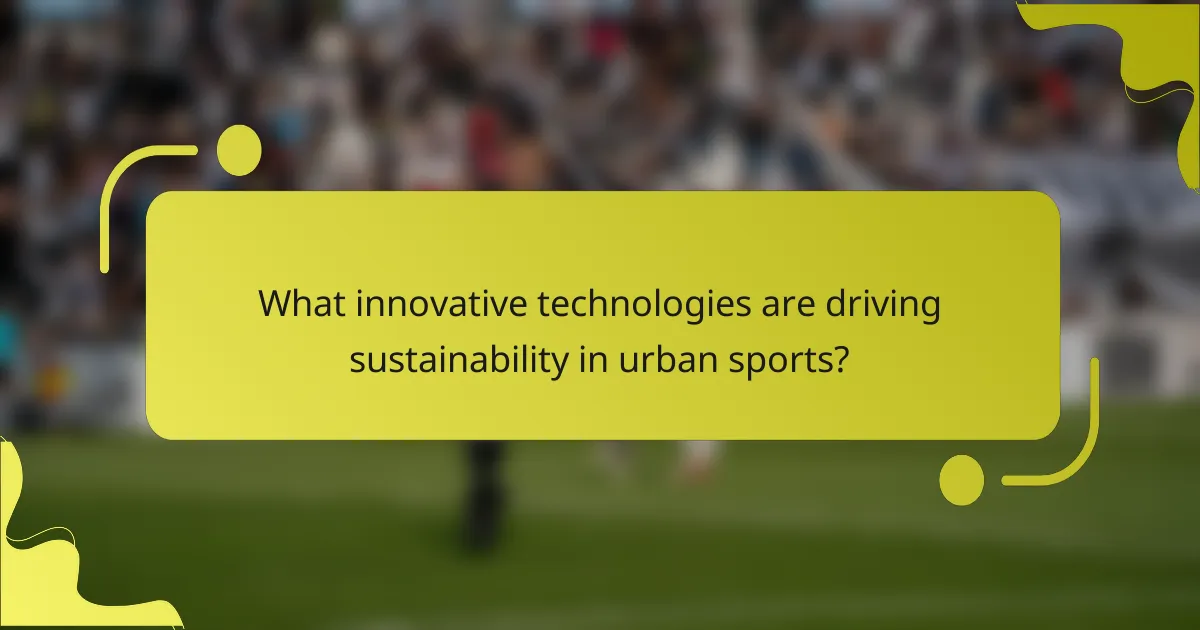
What innovative technologies are driving sustainability in urban sports?
Innovative technologies driving sustainability in urban sports include renewable energy solutions that power sports venues. These solutions reduce carbon footprints and enhance energy efficiency. Solar panels, wind turbines, and energy-efficient lighting are commonly implemented. For instance, solar energy can provide up to 30% of a venue’s total energy needs, supporting eco-friendly operations. Additionally, smart water management systems minimize waste and optimize usage. Implementing these technologies not only promotes sustainability but also attracts environmentally conscious audiences.
How do smart technologies enhance energy efficiency in sports venues?
Smart technologies significantly enhance energy efficiency in sports venues by optimizing energy consumption and integrating renewable sources. These technologies include smart lighting systems that adjust based on occupancy, energy management systems that monitor and control energy usage, and renewable energy installations such as solar panels. For example, smart lighting can reduce energy use by up to 75% when venues are not fully occupied. Additionally, energy management systems can provide real-time data on consumption patterns, enabling venues to make informed decisions that further reduce waste. As a result, sports venues can lower operational costs and minimize their carbon footprint, aligning with sustainability goals.
What role do energy storage systems play in renewable energy management?
Energy storage systems are crucial for optimizing renewable energy management in sports venues. They store excess energy generated during peak production times, ensuring a steady supply during high-demand periods. This balance enhances energy efficiency and reduces reliance on non-renewable sources. Additionally, energy storage can support grid stability, allowing venues to participate in demand response programs. As a result, sports venues can achieve sustainability goals while minimizing operational costs.
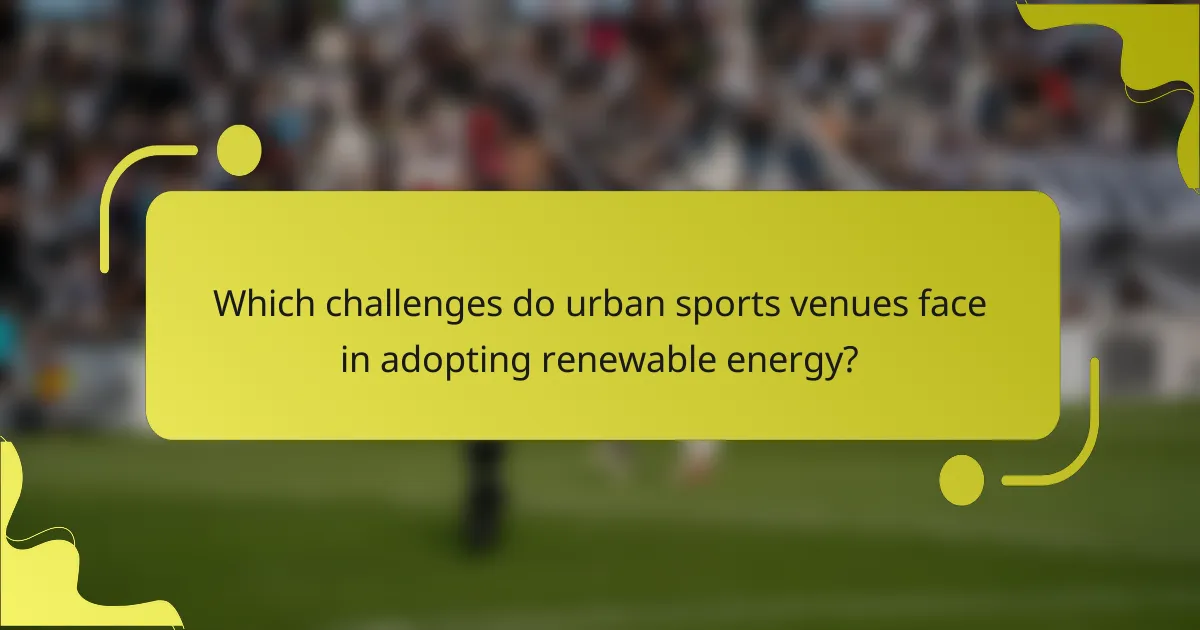
Which challenges do urban sports venues face in adopting renewable energy?
Urban sports venues face significant challenges in adopting renewable energy, including high initial costs, regulatory hurdles, and technological limitations. Financial constraints often impede investment in renewable infrastructure. Additionally, inconsistent energy supply from renewable sources can disrupt operations. Furthermore, venues may lack the necessary expertise to implement and maintain these systems effectively. Lastly, there may be resistance from stakeholders accustomed to traditional energy sources.
How can sports venues overcome regulatory hurdles for renewable energy implementation?
Sports venues can overcome regulatory hurdles for renewable energy implementation by engaging with local governments and stakeholders. Building partnerships can streamline the permitting process and enhance compliance with regulations.
Additionally, venues should invest in education and advocacy to raise awareness of the benefits of renewable energy. This can foster community support, leading to more favorable policies.
Utilizing innovative financing options, such as green bonds or public-private partnerships, can also provide the necessary capital for renewable energy projects.
Finally, venues can adopt best practices from other successful implementations to navigate complex regulations effectively. This approach not only ensures compliance but also promotes sustainability in urban sports.
What are the common misconceptions about renewable energy in sports venues?
Common misconceptions about renewable energy in sports venues include the belief that it is too expensive, unreliable, and difficult to implement. Many assume that renewable energy sources cannot meet the high energy demands of sports events. In reality, advancements in technology have made solar and wind energy more affordable and efficient. Additionally, integrating renewable energy can enhance a venue’s sustainability and attract eco-conscious fans.
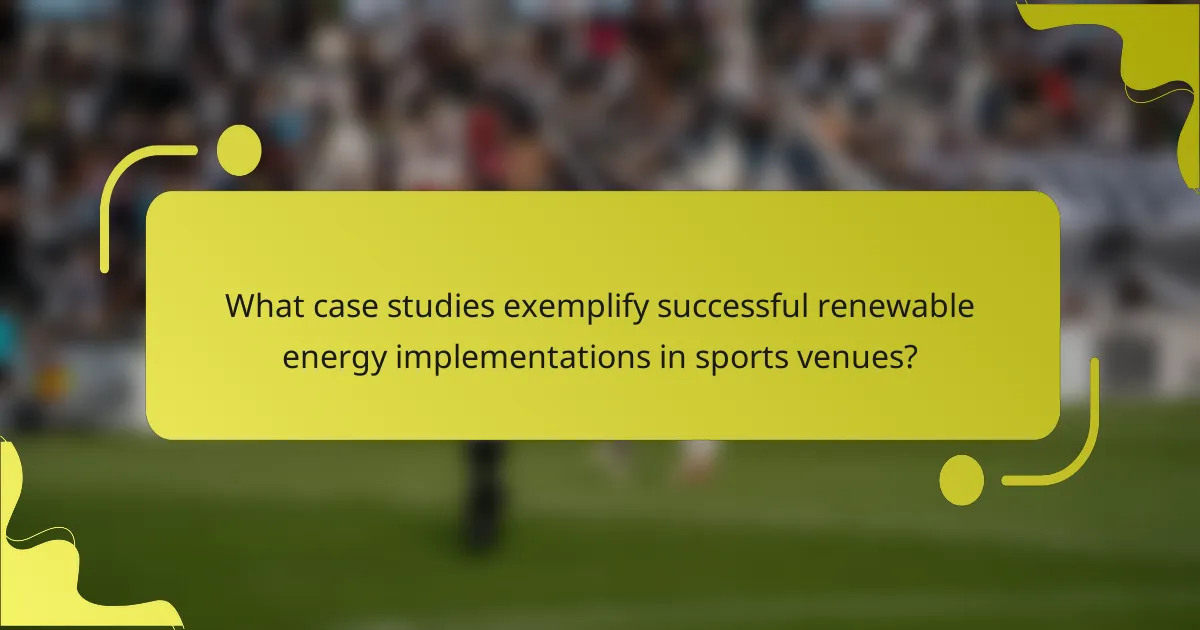
What case studies exemplify successful renewable energy implementations in sports venues?
Several case studies illustrate successful renewable energy implementations in sports venues. The Mercedes-Benz Stadium in Atlanta utilizes a 1.6 MW solar array, significantly reducing energy costs and carbon emissions. The Levi’s Stadium in California features a solar installation that generates 100% of its energy needs on game days. The Allianz Arena in Munich incorporates a unique LED façade powered by renewable energy, enhancing its sustainability profile. These examples demonstrate the effective integration of renewable energy solutions in enhancing both operational efficiency and environmental responsibility within sports venues.
How did a major sporting event leverage renewable energy for sustainability?
A major sporting event can leverage renewable energy by integrating solar and wind energy systems at venues. This approach reduces carbon emissions and promotes sustainability. For instance, the use of solar panels can generate significant energy, powering facilities during events. Additionally, wind turbines can supplement energy needs, ensuring a reliable power source. Many venues are adopting these technologies to enhance their environmental responsibility while providing an engaging experience for attendees.
What lessons can be learned from international examples of sustainable sports venues?
International examples of sustainable sports venues demonstrate the effectiveness of renewable energy solutions. Venues like the Mercedes-Benz Stadium in Atlanta utilize solar panels and rainwater harvesting systems, significantly reducing their carbon footprint. The London 2012 Olympic Park incorporated extensive green spaces and energy-efficient technologies, showcasing a commitment to sustainability. Additionally, the Allianz Arena in Munich features a unique facade that generates energy, illustrating innovative design in sports infrastructure. These cases highlight the potential for integrating renewable energy in urban sports venues, promoting environmental stewardship and community engagement.
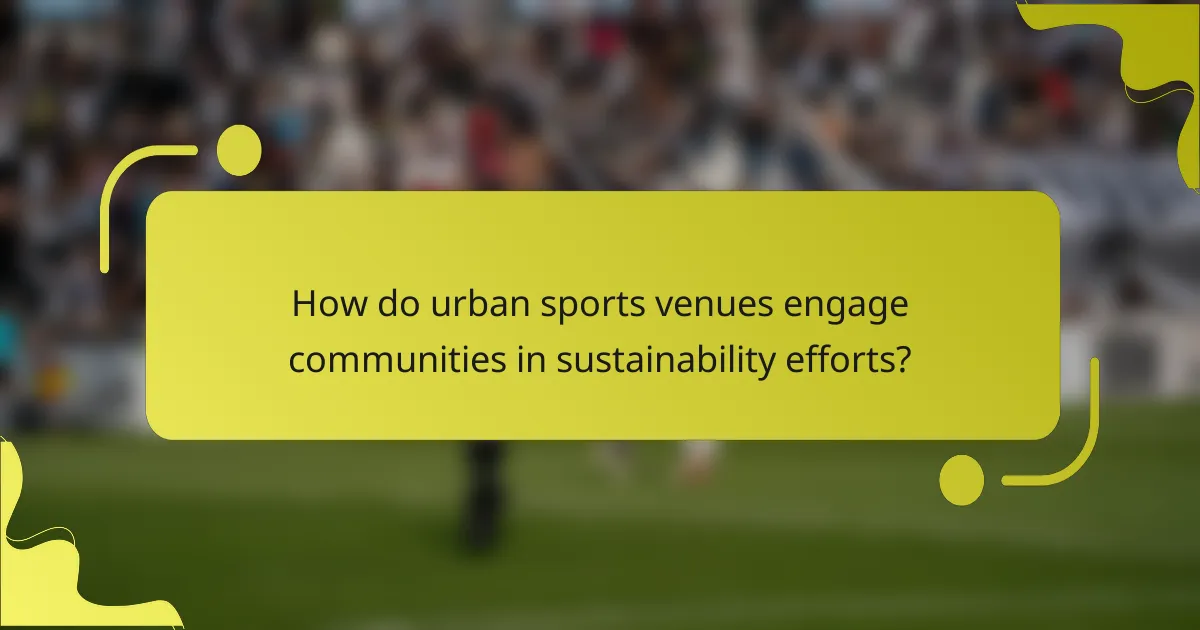
How do urban sports venues engage communities in sustainability efforts?
Urban sports venues engage communities in sustainability efforts through renewable energy initiatives. These venues often incorporate solar panels and wind turbines to power operations, reducing carbon footprints. Local partnerships enhance community involvement, promoting eco-friendly practices. Events focused on sustainability educate attendees about renewable energy benefits. Additionally, venues often host workshops and activities that encourage sustainable transportation, like biking and public transit. Engaging the community fosters a collective commitment to environmental stewardship.
What programs promote public awareness of renewable energy in sports?
Programs promoting public awareness of renewable energy in sports include initiatives by organizations like the Green Sports Alliance and the Solar Energy Industries Association. These programs focus on educating athletes and fans about sustainable practices and renewable energy solutions for sports venues. They often feature workshops, campaigns, and partnerships that highlight the benefits of renewable energy, such as reducing carbon footprints and enhancing energy efficiency. Collaboration with local communities further amplifies awareness and engagement in sustainability efforts.
How can sports venues partner with local governments for sustainability initiatives?
Sports venues can effectively partner with local governments to implement sustainability initiatives by collaborating on renewable energy projects. Such partnerships can enhance energy efficiency, reduce carbon footprints, and promote community engagement.
Joint efforts may include the installation of solar panels, wind turbines, or energy-efficient systems, benefiting both the venue and local residents. For example, venues can leverage government grants and incentives to fund these sustainable upgrades, making them financially viable.
Additionally, sharing resources and expertise allows for the development of comprehensive sustainability plans. These plans can include waste reduction strategies, water conservation measures, and public transportation initiatives, creating a holistic approach to urban sustainability.
Ultimately, these collaborations foster a shared commitment to environmental stewardship while enhancing the community’s overall quality of life.
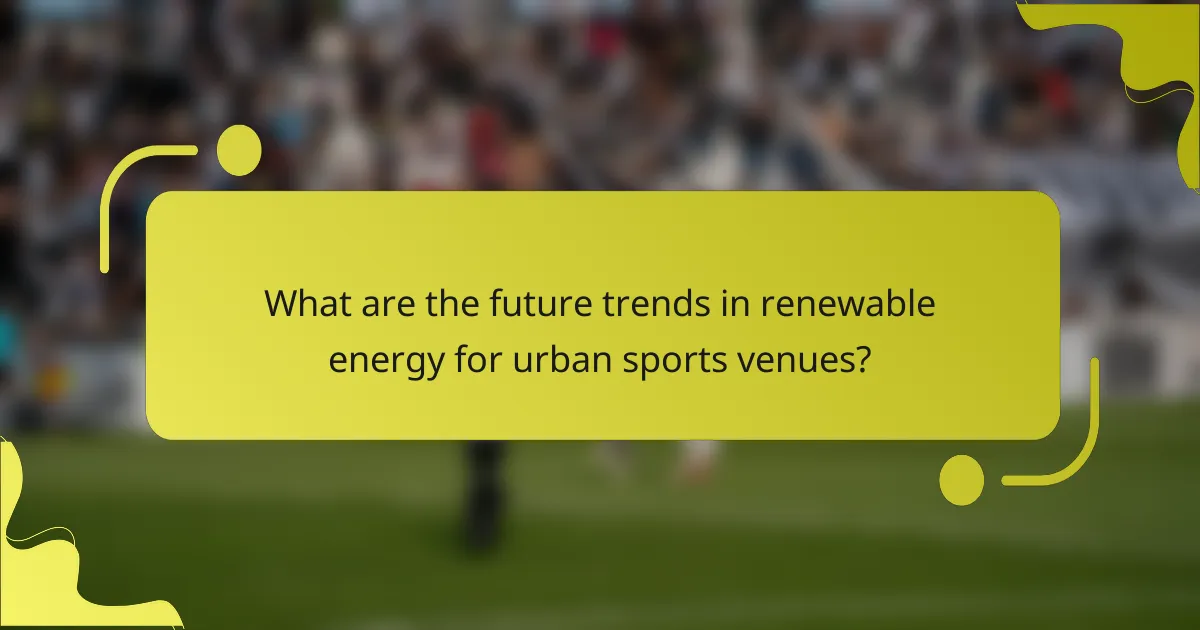
What are the future trends in renewable energy for urban sports venues?
Future trends in renewable energy for urban sports venues focus on solar, wind, and energy storage solutions. These venues increasingly adopt solar panels for energy generation, enhancing sustainability. Wind turbines are also gaining traction, providing clean energy in urban settings. Energy storage systems, like batteries, ensure a reliable power supply during peak demand. Additionally, smart grid technology optimizes energy use, enabling venues to manage resources efficiently. These innovations contribute to reducing carbon footprints and promoting eco-friendly practices in urban sports environments.
How might emerging technologies reshape the energy landscape of sports venues?
Emerging technologies will significantly reshape the energy landscape of sports venues by integrating renewable energy solutions. Smart grids and energy storage systems will optimize energy use and reduce costs. Solar panels and wind turbines will harness natural resources, promoting sustainability. Additionally, energy-efficient designs and smart building technologies will minimize waste and enhance operational efficiency. These innovations will not only lower carbon footprints but also engage fans in sustainability efforts, creating a more environmentally conscious sports culture.
What role will policy changes play in the evolution of renewable energy in sports?
Policy changes will significantly accelerate the adoption of renewable energy in sports venues. These changes create incentives for sustainable practices, such as tax breaks and funding for green technologies. As a result, sports organizations can invest in solar panels, wind energy, and energy-efficient systems. This transition not only reduces carbon footprints but also enhances the overall sustainability of urban sports. Furthermore, policies that mandate renewable energy use will push venues to innovate, leading to unique attributes in energy management, such as smart grids and energy storage solutions.
What best practices should urban sports venues adopt for sustainable energy solutions?
Urban sports venues should adopt renewable energy solutions such as solar panels, wind turbines, and energy-efficient systems. These practices reduce carbon footprints and lower operational costs. Integrating smart technology enhances energy management. Collaborating with local governments can secure funding and incentives. Regular audits ensure continuous improvement in energy efficiency.
